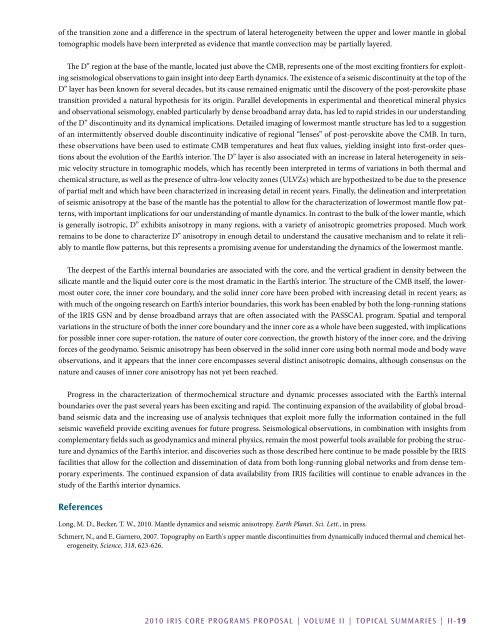Download Volume II Accomplisments (28 Mb pdf). - IRIS
Download Volume II Accomplisments (28 Mb pdf). - IRIS
Download Volume II Accomplisments (28 Mb pdf). - IRIS
You also want an ePaper? Increase the reach of your titles
YUMPU automatically turns print PDFs into web optimized ePapers that Google loves.
of the transition zone and a difference in the spectrum of lateral heterogeneity between the upper and lower mantle in global<br />
tomographic models have been interpreted as evidence that mantle convection may be partially layered.<br />
The D” region at the base of the mantle, located just above the CMB, represents one of the most exciting frontiers for exploiting<br />
seismological observations to gain insight into deep Earth dynamics. The existence of a seismic discontinuity at the top of the<br />
D” layer has been known for several decades, but its cause remained enigmatic until the discovery of the post-perovskite phase<br />
transition provided a natural hypothesis for its origin. Parallel developments in experimental and theoretical mineral physics<br />
and observational seismology, enabled particularly by dense broadband array data, has led to rapid strides in our understanding<br />
of the D” discontinuity and its dynamical implications. Detailed imaging of lowermost mantle structure has led to a suggestion<br />
of an intermittently observed double discontinuity indicative of regional “lenses” of post-perovskite above the CMB. In turn,<br />
these observations have been used to estimate CMB temperatures and heat flux values, yielding insight into first-order questions<br />
about the evolution of the Earth’s interior. The D” layer is also associated with an increase in lateral heterogeneity in seismic<br />
velocity structure in tomographic models, which has recently been interpreted in terms of variations in both thermal and<br />
chemical structure, as well as the presence of ultra-low velocity zones (ULVZs) which are hypothesized to be due to the presence<br />
of partial melt and which have been characterized in increasing detail in recent years. Finally, the delineation and interpretation<br />
of seismic anisotropy at the base of the mantle has the potential to allow for the characterization of lowermost mantle flow patterns,<br />
with important implications for our understanding of mantle dynamics. In contrast to the bulk of the lower mantle, which<br />
is generally isotropic, D” exhibits anisotropy in many regions, with a variety of anisotropic geometries proposed. Much work<br />
remains to be done to characterize D” anisotropy in enough detail to understand the causative mechanism and to relate it reliably<br />
to mantle flow patterns, but this represents a promising avenue for understanding the dynamics of the lowermost mantle.<br />
The deepest of the Earth’s internal boundaries are associated with the core, and the vertical gradient in density between the<br />
silicate mantle and the liquid outer core is the most dramatic in the Earth’s interior. The structure of the CMB itself, the lowermost<br />
outer core, the inner core boundary, and the solid inner core have been probed with increasing detail in recent years; as<br />
with much of the ongoing research on Earth’s interior boundaries, this work has been enabled by both the long-running stations<br />
of the <strong>IRIS</strong> GSN and by dense broadband arrays that are often associated with the PASSCAL program. Spatial and temporal<br />
variations in the structure of both the inner core boundary and the inner core as a whole have been suggested, with implications<br />
for possible inner core super-rotation, the nature of outer core convection, the growth history of the inner core, and the driving<br />
forces of the geodynamo. Seismic anisotropy has been observed in the solid inner core using both normal mode and body wave<br />
observations, and it appears that the inner core encompasses several distinct anisotropic domains, although consensus on the<br />
nature and causes of inner core anisotropy has not yet been reached.<br />
Progress in the characterization of thermochemical structure and dynamic processes associated with the Earth’s internal<br />
boundaries over the past several years has been exciting and rapid. The continuing expansion of the availability of global broadband<br />
seismic data and the increasing use of analysis techniques that exploit more fully the information contained in the full<br />
seismic wavefield provide exciting avenues for future progress. Seismological observations, in combination with insights from<br />
complementary fields such as geodynamics and mineral physics, remain the most powerful tools available for probing the structure<br />
and dynamics of the Earth’s interior, and discoveries such as those described here continue to be made possible by the <strong>IRIS</strong><br />
facilities that allow for the collection and dissemination of data from both long-running global networks and from dense temporary<br />
experiments. The continued expansion of data availability from <strong>IRIS</strong> facilities will continue to enable advances in the<br />
study of the Earth’s interior dynamics.<br />
References<br />
Long, M. D., Becker, T. W., 2010. Mantle dynamics and seismic anisotropy. Earth Planet. Sci. Lett., in press.<br />
Schmerr, N., and E. Garnero, 2007. Topography on Earth's upper mantle discontinuities from dynamically induced thermal and chemical heterogeneity,<br />
Science, 318, 623-626.<br />
2010 <strong>IRIS</strong> Core Programs Proposal | <strong>Volume</strong> <strong>II</strong> | Topical Summaries | <strong>II</strong>-19
















